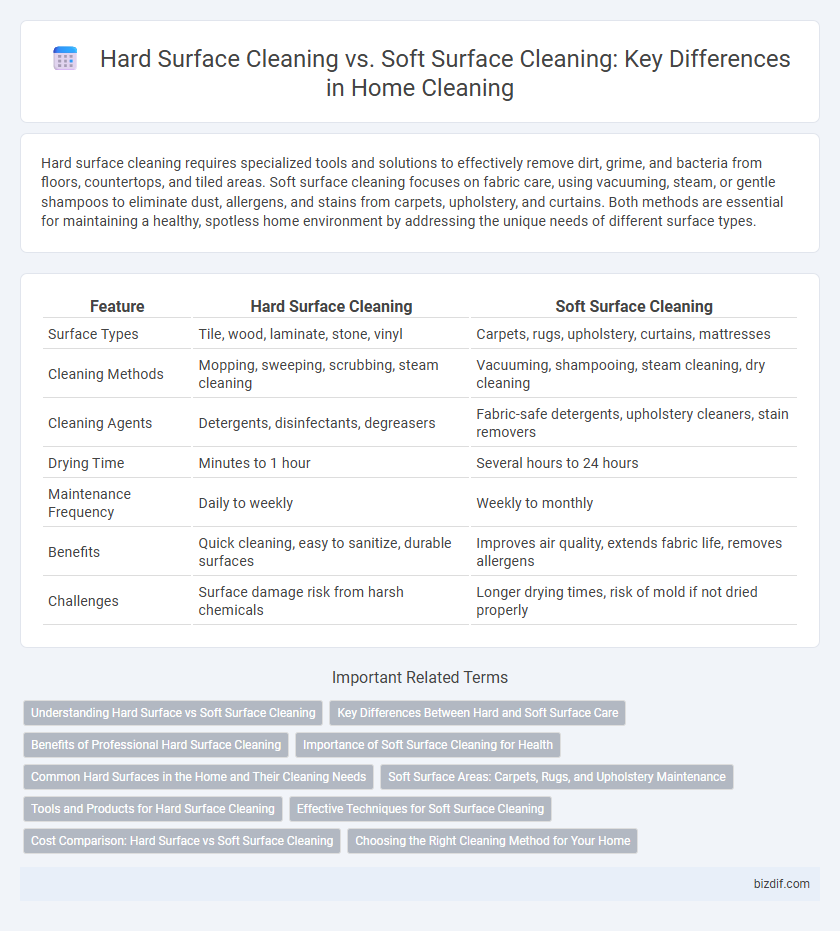Hard surface cleaning requires specialized tools and solutions to effectively remove dirt, grime, and bacteria from floors, countertops, and tiled areas. Soft surface cleaning focuses on fabric care, using vacuuming, steam, or gentle shampoos to eliminate dust, allergens, and stains from carpets, upholstery, and curtains. Both methods are essential for maintaining a healthy, spotless home environment by addressing the unique needs of different surface types.
Table of Comparison
| Feature | Hard Surface Cleaning | Soft Surface Cleaning |
|---|---|---|
| Surface Types | Tile, wood, laminate, stone, vinyl | Carpets, rugs, upholstery, curtains, mattresses |
| Cleaning Methods | Mopping, sweeping, scrubbing, steam cleaning | Vacuuming, shampooing, steam cleaning, dry cleaning |
| Cleaning Agents | Detergents, disinfectants, degreasers | Fabric-safe detergents, upholstery cleaners, stain removers |
| Drying Time | Minutes to 1 hour | Several hours to 24 hours |
| Maintenance Frequency | Daily to weekly | Weekly to monthly |
| Benefits | Quick cleaning, easy to sanitize, durable surfaces | Improves air quality, extends fabric life, removes allergens |
| Challenges | Surface damage risk from harsh chemicals | Longer drying times, risk of mold if not dried properly |
Understanding Hard Surface vs Soft Surface Cleaning
Hard surface cleaning targets materials such as tile, hardwood, and laminate, requiring specific cleaners and tools to remove dirt, grime, and bacteria without damaging the finish. Soft surface cleaning involves sofas, carpets, and curtains, necessitating fabric-safe detergents and techniques like vacuuming or steam cleaning to eliminate stains and allergens. Understanding the distinct methods and products for each surface type ensures effective cleaning and maintenance while preserving the integrity of home surfaces.
Key Differences Between Hard and Soft Surface Care
Hard surface cleaning involves non-porous materials such as tile, wood, or laminate floors that require specific solutions to prevent scratches and preserve finish. Soft surface cleaning targets porous materials like carpets, rugs, and upholstery, emphasizing stain removal and deep fiber cleansing with specialized shampoos or steam treatments. The key differences lie in the cleaning methods, tools used, and product formulations optimized to protect the integrity and longevity of each surface type.
Benefits of Professional Hard Surface Cleaning
Professional hard surface cleaning enhances durability and appearance by removing ingrained dirt, bacteria, and allergens from materials like tile, hardwood, and laminate, using specialized equipment and eco-friendly solutions. This process prevents surface damage and extends the lifespan of floors, countertops, and walls while maintaining a hygienic environment. Experts ensure effective stain removal and restore shine, improving overall indoor air quality and boosting property value.
Importance of Soft Surface Cleaning for Health
Soft surface cleaning plays a crucial role in maintaining indoor air quality by effectively removing dust mites, allergens, and bacteria trapped in carpets, upholstery, and curtains. Unlike hard surfaces, soft surfaces can harbor microorganisms and pollutants that contribute to respiratory issues and allergies if not properly cleaned. Regular and thorough cleaning of these fabrics using appropriate methods reduces health risks and promotes a healthier living environment.
Common Hard Surfaces in the Home and Their Cleaning Needs
Common hard surfaces in the home include tile, hardwood, laminate, and granite, each requiring specific cleaning methods to maintain their durability and appearance. Tile surfaces need regular scrubbing with non-abrasive cleaners to prevent grout buildup, while hardwood demands gentle cleaning products that protect the wood finish without causing damage. Granite countertops should be cleaned with pH-balanced solutions to avoid etching and preserve the stone's natural shine.
Soft Surface Areas: Carpets, Rugs, and Upholstery Maintenance
Soft surface cleaning targets carpets, rugs, and upholstery, focusing on removing embedded dirt, stains, and allergens to maintain fabric integrity and extend lifespan. Effective cleaning methods include vacuuming, steam cleaning, and using specialized detergents formulated for delicate fibers. Regular maintenance enhances indoor air quality and prevents microbial growth, ensuring a healthier living environment.
Tools and Products for Hard Surface Cleaning
Effective hard surface cleaning relies on specialized tools such as microfiber mops, scrub brushes, and steam cleaners designed to tackle dirt and grime on floors, tiles, and countertops. Cleaning products with pH-balanced formulas, including all-purpose cleaners and disinfectants, help remove stains while preserving surface integrity. Proper use of these tools and products ensures a thorough, streak-free finish on materials like hardwood, laminate, and ceramic.
Effective Techniques for Soft Surface Cleaning
Soft surface cleaning requires specialized techniques such as vacuuming with HEPA filters to remove dust and allergens effectively, and steam cleaning to penetrate fabric fibers and eliminate bacteria. Using enzyme-based detergents and gentle brushes can break down stains without damaging delicate materials like upholstery and carpets. Regular rotation and spot treatment further enhance cleanliness and prolong the lifespan of soft surfaces.
Cost Comparison: Hard Surface vs Soft Surface Cleaning
Hard surface cleaning typically costs less than soft surface cleaning due to the ease of cleaning materials like tile, hardwood, or laminate, which require fewer specialized products and less labor time. Soft surface cleaning, such as carpets and upholstery, often involves steam cleaning, stain removal treatments, and longer drying times, increasing overall expenses. On average, hard surface cleaning ranges from $0.10 to $0.50 per square foot, whereas soft surface cleaning can range from $25 to $75 per room depending on the extent of dirt and stain removal needed.
Choosing the Right Cleaning Method for Your Home
Hard surface cleaning targets materials like tile, hardwood, and laminate floors using solutions that break down dirt and bacteria without causing damage, ensuring longevity and shine. Soft surface cleaning involves carpets, rugs, and upholstery, requiring specialized vacuuming and gentle detergents to remove stains and allergens while preserving fabric integrity. Selecting the right cleaning method depends on surface type, material durability, and specific cleaning needs to maintain a healthy, spotless home environment.
Hard surface cleaning vs Soft surface cleaning Infographic

 bizdif.com
bizdif.com